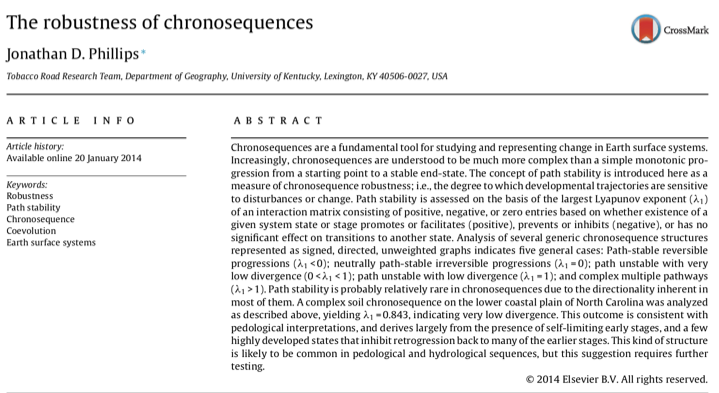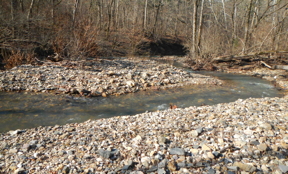ecology
Negotiating Life: Resilience in an Era of the China Dream
Ecological practices of daily life have taken on new urgency and approaches as consumer citizens increasingly voice awareness of environmental sustainability in China. This lecture will focus on "everyday ecologies"--personal engagement with social and material worlds to negotiate well-being.
Professor Nancy Chen is Chair of the Anthropology Department and an affiliate of East Asian Studies and Feminist Studies at UC/Santa Cruz. Her research interests include Chinese biotechnology, food and medicine, and alternative healing practices. She is author or editor of six books, including China Urban.
Sponsored by the Department of Anthropology and the UK Confucius Institute.
New Faculty 2015: Meet Jeremy Van Cleve
Jeremy Van Cleve joined the Department of Biology in the Spring 2015 semester. As one of the newest additions to UK's faculty, Van Cleve had lots of info to share concering his research, his hopes for his future at UK, and how he's getting along in the city of Lexington.
This podcast was produced by David Cole.
Robustness of Chronosequences
The latest issue of Ecological Modelling (vol. 298) is out, a special issue on complexity of soils and hydrology in ecosystems. My article, The Robustness of Chronosequences, is available here. There's a lot of other interesting stuff in the special issue, too. Check it out!

OPTIMALITY IN EARTH SURFACE SYSTEMS
A number of theories in geomorphology, ecology, hydrology, etc. are based on the idea that Earth surface systems (ESS) develop according to some optimal principle or goal function. That is, the ESS develops so as to maximize, minimize, equalize, or optimize some quantity—energy, exergy, entropy, work, mass flux, etc. Some of these notions have some explanatory power and have resulted in some important insights. However, they have always bothered me--no one has ever been able to convince me that there is any inherent, a priori, rule, law, or reason that, e.g., a hillslope or a stream channel or a soil would operate so as to optimize anything. The conservation laws for mass, energy, and momentum are the only laws of nature that absolutely must hold everywhere and always.
So how does one explain the apparent success of some optimality principles in describing, and even predicting, real ESS behavior?
Suppose we use P to represent possible developmental pathways for an ESS. An optimality principle is essentially arguing that a particular P among all those possible is the most likely1. But the sufficient conditions for a particular path need not invoke any extremal or optimal goal functions.
THRESHOLD MODULATION
Not too long ago (Phillips, 2014) I proposed that many geomorphic systems are characterized by divergent behavior driven by either self-reinforcing feedbacks, or by “competitive” mutually-limiting relationships. However, this divergent evolution cannot continue indefinitely, and is ultimately limited by some sort of thresholds. Watts et al. (2014) recently published a paper that I think provides a good example of this sort of behavior a bit different from the ones I cited.
In a low-relief karst wetland landscape in Florida, they found that feedbacks among vegetation, nutrient availability, hydroperiod, and rock weathering (dissolution) result in formation of isolated forested wetland depressions (cypress domes) amongst prairie-type wetlands. However, as the cypress dome (they are called domes because of the taller canopies, despite the depressional landform) features grow, water volume thresholds limit further growth.

Phillips, J.D., 2014. Thresholds, mode-switching and emergent equilibrium in geomorphic systems. Earth Surface Processes and Landforms 39: 71-79.
GEOMORPHOLOGY & INVASIVE SPECIES
Here in the University of Kentucky physical geography program, we have a regular weekly meeting called BRAG (Biogeomorphology Research & Analysis Group) in which various faculty and graduate students from geography and other programs cuss, discuss, debate, and speculate about a wide range of topics centered on geomorphology-ecology interactions. A couple of years ago we focused quite a bit on the biogeomorphic ecosystem engineering effects of invasive species. That led to development of a review paper, which at long last was published, in the Annual Review of Ecology, Evolution, and Systematics—The biogeomorphic impacts of invasive species. The co-authors are myself, Songlin Fei, and Michael Shouse. Songlin, now at Purdue University, was then in the Forestry department at UK, and a regular participant in BRAG. Michael, now at Southern Illinois University-Edwardsville, was then a geography PhD student here.
The abstract is below, and a ScienceDaily news release is here: http://www.sciencedaily.com/releases/2014/12/141211115522.htm
NATURAL SELECTION
Natural selection is most familiar with respect to Darwinian evolution. However, though some biologists will argue that selection acts only on genes, this is a very narrow and restricted view. Selection operates on a variety of environmental phenomena, and at a variety of scales. In hydrology and geomorphology, the principle of gradient selection dictates that the most efficient flow paths are preferred over less efficient ones, and that these paths tend to be reinforced. That’s why water flows organize themselves into channels (more efficient than diffuse flows), and channels into networks. The principle of resistance selection in geomorphology is simply that more resistant features will persist while less resistant ones will be removed more quickly. Thus geomorphic processes select for certain forms and features and against others. Among others, Gerald Nanson, Rowl Twidale, and Luna Leopold have written on selection in geomorphology, and Henry Lin, among others, in hydrology.

Principle of gradient selection at work--Board Camp Creek, Arkansas
THE SEMANTICS OF RESILIENCE
Resistance of environmental systems is their capacity to withstand or absorb force or disturbance with minimal change. In many cases we can measure it based on, e.g., strength or absorptive capacity. Resilience is the ability of a system to recover after a disturbance or applied force to (or toward) its pre-disturbance condition—in many cases a function of dynamical stability. In my classes I illustrate the difference by comparing a steel bar and a rubber band. The steel bar has high resistance and low resilience—you have to apply a great deal of force to bend it, but once bent it stays bent. A rubber band has low resistance and high resilience—it is easily broken, but after any application of force short of the breaking point, it snaps back to its original state.
RIVER RESTORATION & REHABILITATION
Yesterday I heard a very interesting river restoration workshop at the British Society for Geomorphology meeting. What I’m about to discuss was not the focus of the workshop, but it was triggered by thinking about geomorphology, hydrology, and river science in stream rehabilitation and restoration, which is a big business now.
The stream restoration problem is often portrayed as something like this:

That is, the stream is currently in some kind of degraded, suboptimal, unwanted state. The goal is to restore it to a “natural” or some more desired condition, often conceived as whatever the stream was like before the degradation commenced. There are a number of problems with this, one being that in many cases the pre-existing state is not known. Even if it is, since rivers—like other landforms and ecosystems—are dynamic and changeable, there is no particular scientific reason to believe that, in the absence of human-driven changes, the river would still be now as it was decades ago.
